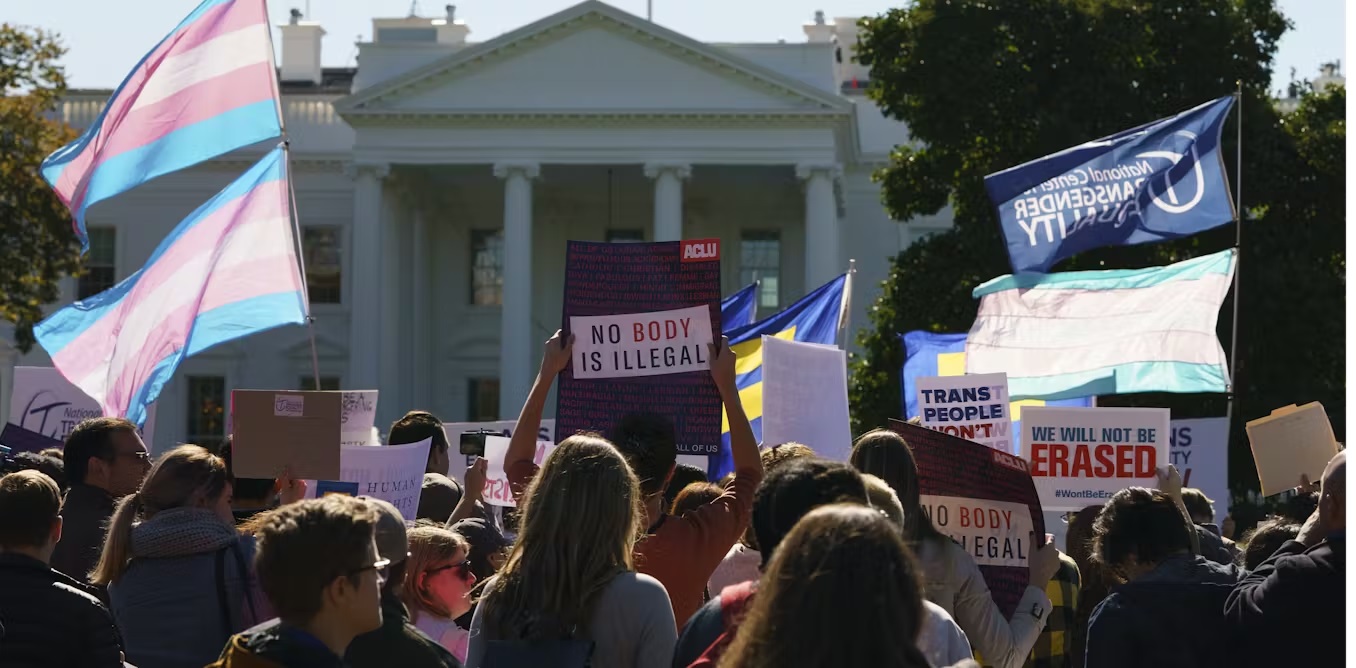Anti-trans legislation adjudicates the bodily autonomy of those who do not conform to gender norms. Carolyn Kaster/AP Photo
Three transgender teenagers and their families have challenged Tennessee’s 2023 restriction on gender-affirming care for minors. The U.S. Supreme Court heard oral arguments in the first week of December.
The World Health Organization defines gender-affirming care as a set of social, psychological, behavioral, and medical interventions that help people affirm their gender identity. Tennessee law specifically prohibits doctors from administering puberty blockers and hormone therapy to minors seeking treatment for gender dysphoria.
According to the American Psychiatric Association, gender dysphoria is the psychological distress caused by an incongruence between one’s assigned sex at birth and one’s gender identity. Gender dysphoria usually develops in childhood; however, some people may not experience it until after puberty or much later.

The families contesting Tennessee’s ban argue that it violates the 14th amendment’s concept of equal protection under the law by treating transgender boys and girls differently from other boys and girls, resulting in discrimination. The families also think that the state violates a parent’s right to make medical decisions for their child and that the state harms children by denying them necessary medical care.
One plaintiff is a 16-year-old girl who received gender-affirming therapy. The teen described her gender dysphoria as a “real-life body horror” and stated that the treatment helped her “feel normal.” Tennessee’s ban forces the teen’s parents to travel out of state for her treatment.
Advocates for transgender rights support the 16-year-old’s “right to be a girl” in Tennessee.
Tennessee maintains that the state’s ban on gender-affirming treatments is not sex-based discrimination, nor does it withhold treatment because a person is transgender. The ban distinguishes between the purposes for giving puberty blockers and hormone therapy. The ban was established because the majority of the state’s representatives believe the state has a “compelling interest in encouraging minors to appreciate their sex” and forbidding procedures “that might encourage minors to become disdainful of their sex.”
Transgender issues will be the Supreme Court’s most high-profile and politically charged cases in the post-Roe/post-affirmative action era. Outside the Supreme Court, there were competing demonstrations. Demonstrators in support of Tennessee’s ban held placards that read “Champion God’s design,” while their opponents chanted “Freedom to be ourselves.” Inside the Supreme Court, the liberal justices had their own legal disagreements with their conservative colleagues, who dominate the bench.
Chief Justice Roberts remained unconvinced that courts, rather than legislatures, should regulate medical procedures, a decision often left to states. Tennessee voters elected their legislators, and the ban on gender-affirming care is the result of that democratic process.
Justice Sonia Sotomayor disagreed with Robert’s premise. She contended that the democratic process is not always the best approach to address complaints to the law, particularly when the law has a negative impact on a minority community that lacks the numbers to influence the democratic process. Sotomayer noted that transgender persons account for fewer than one percent of the population and then reminded the court that African Americans constituted a bigger proportion of the population, and the democratic process failed to protect them from Jim Crow.
The Supreme Court will not rule on this case until several months into 2025, but the oral arguments allowed the public to see past the legal issues and consider the underlying human concern.
Justice Sotomayor was concerned that the suicide rate among minors with gender dysphoria is both high and worrisome. As a result, it is reasonable that parents seek gender-affirming care for their minors in order to prevent suicide. The lawyer representing the families’ informed the court that many studies had shown that gender-affirming care lowered the likelihood of depression, anxiety, and suicidality (thoughts or intent to try suicide).
In contrast, Justice Samuel Alito claimed that there was no proof that gender-affirming treatment prevented or reduced suicide. Justice Brett Kavanaugh remarked that the court could not overlook detransitioners—people who regret getting gender-affirming treatment earlier in their lives and wish to detransition. Suppose an individual underwent gender-affirming treatment in adolescence that improved their quality of life but later regretted their decision, fell into serious despair, and committed suicide. The gender-affirming treatment then becomes a long-term risk factor for suicide rather than a preventive intervention.
Justice Kavanaugh described the complexity of the dilemma that the case brought to the court. The justices were being asked to weigh the risks for one group of people—minors who would suffer if Tennessee’s ban on gender-affirming care was upheld because they benefit from the treatment—versus the risks of other people who would be harmed if gender-affirming care for minors was allowed and they received treatment they later regretted.
Justice Kavanaugh presented a question not only for the court but also for all those that treat the case as a culture war battle and already chose their side.
He asked, “How do we choose which set of risks is more serious?”

